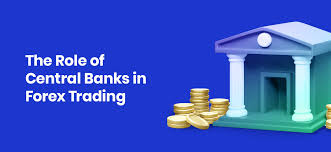Central banks play a significant role in the foreign exchange (forex) market, influencing currency values, liquidity, and overall market stability. Their actions can have a major impact on exchange rates and the global economy. Below are the primary roles that central banks play in the forex market:
1. Monetary Policy Implementation
Central banks use monetary policy as a key tool to control economic stability, and their decisions directly affect forex markets. The two main components of monetary policy are:
Interest Rates: Central banks set the benchmark interest rates, which can influence the value of a currency. Higher interest rates generally attract foreign capital, increasing demand for the currency, which can cause it to appreciate. Conversely, lower interest rates can lead to a depreciation of the currency as investors seek higher returns elsewhere.
Example: If the U.S. Federal Reserve raises interest rates, it can strengthen the U.S. dollar against other currencies.
Quantitative Easing (QE): When central banks engage in QE (purchasing government bonds or other financial assets), they increase the money supply, which can lead to a depreciation of the currency. The goal is to stimulate the economy by making borrowing cheaper and increasing liquidity.
Example: The Bank of Japan has used QE in the past to keep the yen weak and support its export-driven economy.
2. Currency Interventions (Forex Interventions)
Central banks sometimes intervene directly in the forex market to stabilize or influence the value of their currency. This intervention can take two forms:
Direct Intervention: The central bank buys or sells its own currency in the open market. For instance, if a country’s currency is appreciating too much (which might hurt exports), the central bank could sell its own currency and buy foreign currencies to weaken its currency.
Indirect Intervention: Central banks can influence forex markets through verbal or written statements, signaling their intent to act if necessary. These statements can cause market participants to adjust their positions accordingly.
Example: The Swiss National Bank (SNB) has historically intervened in the forex market to prevent the Swiss franc from appreciating too much, as this would harm Swiss exports.
3. Regulation and Oversight
Central banks regulate and supervise the financial institutions within their jurisdiction to ensure the stability of the financial system. They also help manage the risks that may arise from foreign exchange activities, especially speculative trading. By setting guidelines, maintaining liquidity, and ensuring compliance with rules, central banks promote confidence in the forex market.
4. Foreign Exchange Reserves Management
Central banks hold foreign exchange reserves, which are large quantities of foreign currencies that are used to:
Stabilize the value of their own currency during periods of volatility.
Influence exchange rates (through direct intervention as mentioned earlier).
Meet international payment obligations and maintain confidence in the country’s financial system.
Reserves management ensures that a country has enough foreign currency to pay for imports, settle debts, and defend the national currency from speculative attacks.
Example: Countries like China and Russia hold vast foreign exchange reserves to support their domestic currencies and manage economic crises.
5. Exchange Rate Policies
Some central banks adopt specific exchange rate policies:
Fixed Exchange Rate: In some cases, a central bank may peg the value of its currency to another currency (like the U.S. dollar or the euro). The central bank then commits to maintaining this fixed rate by buying or selling its currency in the forex market.
Example: The Hong Kong Monetary Authority maintains a peg between the Hong Kong dollar and the U.S. dollar.
Floating Exchange Rate: In a floating exchange rate system, the value of the currency is determined by market forces (supply and demand), though central banks may still intervene if they believe their currency’s value is too volatile or damaging to the economy.
6. Inflation Targeting
Central banks aim to keep inflation within a target range, as inflation directly impacts currency value. High inflation tends to reduce the purchasing power of a currency and can cause it to depreciate. To combat inflation, central banks may raise interest rates, which can make the currency more attractive to foreign investors, increasing demand for the currency and potentially strengthening it.
Example: The European Central Bank (ECB) targets inflation at close to, but below, 2% to maintain the euro’s value in the global market.
7. Global Economic Coordination
Central banks, especially those of major economies (such as the U.S. Federal Reserve, the European Central Bank, and the Bank of Japan), coordinate their actions in times of economic or financial crises. For instance, they may agree to lower interest rates together, or engage in coordinated currency interventions, to prevent economic instability or to respond to global financial crises.
Example: During the 2008 financial crisis, the Federal Reserve, ECB, and Bank of England coordinated their monetary policy to stabilize global financial markets and prevent further currency depreciation.
8. Market Sentiment and Speculation
Central banks can also influence market sentiment and speculative behavior through their policy signals and communications. Traders often react to central bank guidance, such as speeches or reports, which can lead to significant movements in the forex market.

